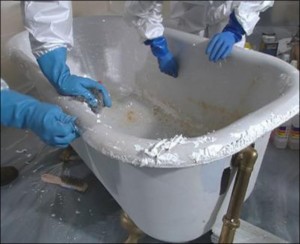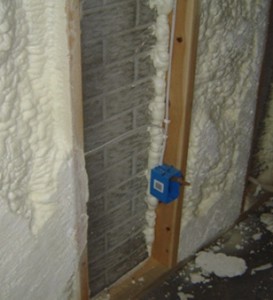 At least 14 workers have died since 2000 as a result of using stripping agents containing methylene chloride during bathtub refinishing. Many stripping products (including those that may also be available to consumers) contain high percentages of methylene chloride. Methylene chloride is extremely dangerous when not used properly. Alternative products and processes exist for bathtub refinishing. Products containing methylene chloride should be avoided when possible. Earlier this week NIOSH and OSHA released a joint Hazard Alert titled Methylene Chloride Hazards for Bathtub Refinishers.
At least 14 workers have died since 2000 as a result of using stripping agents containing methylene chloride during bathtub refinishing. Many stripping products (including those that may also be available to consumers) contain high percentages of methylene chloride. Methylene chloride is extremely dangerous when not used properly. Alternative products and processes exist for bathtub refinishing. Products containing methylene chloride should be avoided when possible. Earlier this week NIOSH and OSHA released a joint Hazard Alert titled Methylene Chloride Hazards for Bathtub Refinishers.
Selected Category: Exposure
Dangers of Bathtub Refinishing
Categories: Chemicals, Exposure
February 4th, 2013 3:09 pm ET - Ronald M. Hall, CDR, USPHS, MS, CIH, CSP
Catching the Flu: NIOSH Research on Airborne Influenza Transmission
Categories: Exposure, Health care, Personal protective equipment
January 15th, 2013 9:42 am ET - William G. Lindsley, PhD
As we enter another influenza season, one question continues to vex medical and public health professionals: How do you stop people from catching the flu? The best way to prevent the flu is by getting an influenza vaccine every year. However, in the event of a large-scale influenza outbreak of a new virus strain or a pandemic, when influenza vaccine may not be promptly available, we will see tremendous demands on the health care system and its workers. Thus, it’s critical to understand how influenza is transmitted from person to person so that we can determine the best ways to protect health care workers while still enabling them to do their jobs.
The typical incubation period for influenza is 1-4 days (average: 2 days). Adults shed influenza virus from the day before symptoms begin through 5-10 days after illness onset. However, the amount of virus shed, and presumably infectivity, decreases rapidly by 3-5 days after onset in an experimental human infection model. Young children also might shed virus several days before illness onset, and children can be infectious for 10 or more days after onset of symptoms. Severely immunocompromised persons can shed virus for weeks or months.
Safety and Health in the Theater: Keeping Tragedy out of the Comedies…and Musicals…and Dramas
Categories: Chemicals, Construction, Ergonomics, Exposure, Hearing loss, Sports and entertainment
June 11th, 2012 11:05 am ET - Gregory A. Burr, CIH and Deborah Hornback, MS
 On Sunday, the 2012 Tony Awards celebrated the year’s best offerings from “The Great White Way.” While the theater provides entertainment, the preparation and production of live performances can also pose hazards to those working in all aspects of the theater –from actors on stage to set designers behind the scenes and musicians in the orchestra pit. Some of these hazards were well publicized in recent years as multiple actors and stunt doubles were injured during the production of Spiderman, Turn off the Dark. These injuries included harness failure, injuries sustained during flying sequences and actors struck by equipment[i]. With the complexities of a theatrical production, there are numerous potential hazards. In fact, one hazard, a falling backdrop, is portrayed in the musical The Phantom of the Opera. But the Phantom wasn’t to blame when a large backdrop hit Bret Michaels on the head after performing with the cast of Rock of Ages during the 2009 Tony Awards [ii]. Other potential hazards in the theater include rigging and flying hazards, repetitive strain injuries among dancers and carpenters, solvent and chemical exposures, noise-induced hearing loss, electrical hazards, falls from heights, as well as most hazards found on a construction site.
On Sunday, the 2012 Tony Awards celebrated the year’s best offerings from “The Great White Way.” While the theater provides entertainment, the preparation and production of live performances can also pose hazards to those working in all aspects of the theater –from actors on stage to set designers behind the scenes and musicians in the orchestra pit. Some of these hazards were well publicized in recent years as multiple actors and stunt doubles were injured during the production of Spiderman, Turn off the Dark. These injuries included harness failure, injuries sustained during flying sequences and actors struck by equipment[i]. With the complexities of a theatrical production, there are numerous potential hazards. In fact, one hazard, a falling backdrop, is portrayed in the musical The Phantom of the Opera. But the Phantom wasn’t to blame when a large backdrop hit Bret Michaels on the head after performing with the cast of Rock of Ages during the 2009 Tony Awards [ii]. Other potential hazards in the theater include rigging and flying hazards, repetitive strain injuries among dancers and carpenters, solvent and chemical exposures, noise-induced hearing loss, electrical hazards, falls from heights, as well as most hazards found on a construction site.
Help Wanted: Spray Polyurethane Foam Insulation Research
Categories: Chemicals, Construction, Exposure, Green, Personal protective equipment
March 21st, 2012 1:55 pm ET - David A. Marlow, BS
 Environmentally friendly doesn’t necessarily mean worker friendly. In many cases, new “green” technologies and products have reached the market without being adequately evaluated to determine whether they pose health or safety risks to workers in manufacture, deployment, or use. Spray polyurethane foam—commonly referred to as SPF—is a case in point. Its use as insulation has been on the upswing because of the laudable aim of builders and property owners to improve energy efficiency. As popular as it has become, however, much remains unknown about spray polyurethane foam—specifically the health implications of its amines, glycols, and phosphate upon workers.
Environmentally friendly doesn’t necessarily mean worker friendly. In many cases, new “green” technologies and products have reached the market without being adequately evaluated to determine whether they pose health or safety risks to workers in manufacture, deployment, or use. Spray polyurethane foam—commonly referred to as SPF—is a case in point. Its use as insulation has been on the upswing because of the laudable aim of builders and property owners to improve energy efficiency. As popular as it has become, however, much remains unknown about spray polyurethane foam—specifically the health implications of its amines, glycols, and phosphate upon workers.
Polyurethane foam has a high R-factor (or R-value), so it resists the flow of heat and, when used as insulation, increases a building’s energy efficiency. Because of this, it has become a favorite in the world of energy-conscious construction and renovation. While better insulation clearly means less energy consumption, what’s not clear is the level of protection and ventilation workers need so that they remain safe during the installation process.
Older Posts
Pages
Get email updates
To receive weekly email updates about this site, enter your email address:
Site Categories
- Agriculture, forestry, and fishing
- At-risk populations
- Bloodborne pathogens
- Cancer, reproductive and cardiovascular diseases
- Chemicals
- Construction
- Economics
- Emergency response
- Ergonomics
- Exposure
- Green
- Health care
- Hearing loss
- Media
- Mining
- Nanotechnology
- Oil and gas
- Outdoor work
- Personal protective equipment
- Policy and programs
- Prevention through Design
- Respiratory health
- Sleep
- Small Business
- Sports and entertainment
- Stress
- Technology
- Total Worker Health
- Training
- Transportation
- Uncategorized
- Vehicle safety
- Violence
- Young Workers
About this Site
Contact Us:
- Centers for Disease Control and Prevention
1600 Clifton Rd
Atlanta, GA 30333 - 800-CDC-INFO
(800-232-4636)
TTY: (888) 232-6348 - cdcinfo@cdc.gov


